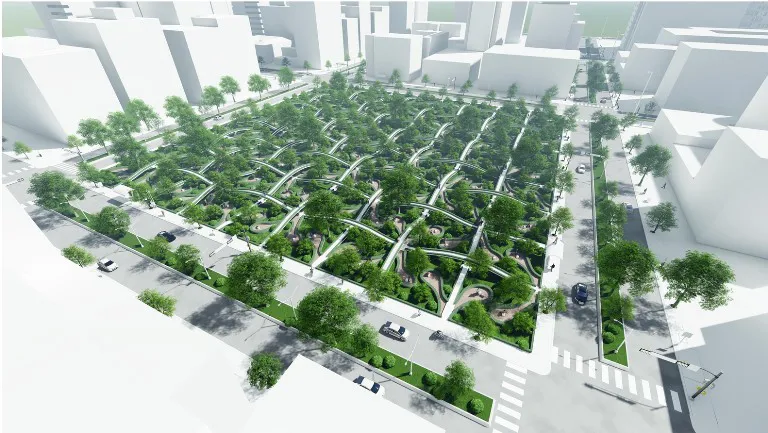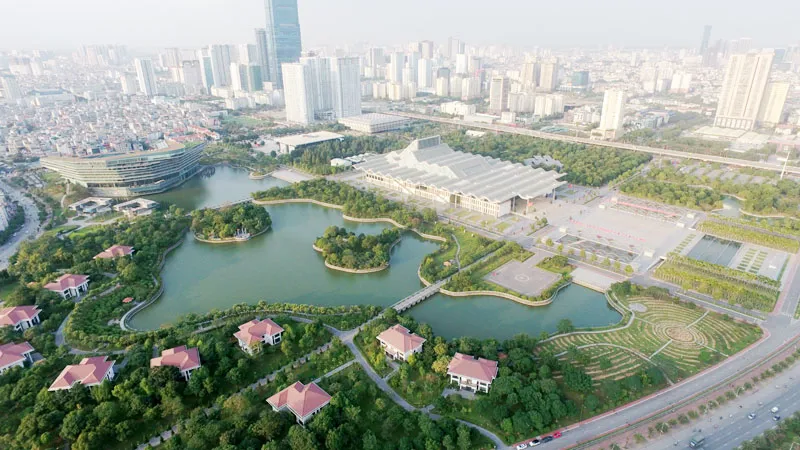Sustainable architectural solutions should anticipate pandemic situation
Many green urban projects have been developed in Hanoi’s suburban areas, as more and more people are looking to find a relaxing living environment that is surrounded by the nature.
In a time when Covid-19 is spreading across the world, the functions of urban architectural spaces such as housing, parks, or stadiums have now been tweaked to better meet the needs of social distancing or preventing possible infection.
While such repurpose is temporary, it has nevertheless provided an opportunity for architecture and urban planners to work on future architectural solutions which would better respond to a future pandemic or natural disaster.
In this context, each urban space should take into account new normalcy when social activities are not disrupted even in the middle of a pandemic.
Nguyen Quoc Thong, former vice president of Vietnam Architecture Association, said as social distancing has become a key solution to deter transmission, this should also be the trend for architecture and planning in the coming time.
“A low construction density is necessary to ensure safety and flexibility so that the people can live with future changes in nature and pandemics,” Thong told The Hanoi Times, saying urban spaces should remain diversified and flexible.
The pandemic has turned many people’s lives upside down, or may even face mental health problems due to a long period of living disconnected from the outside world. In this regard, living green and close to nature should be promoted in the post-pandemic period.
Such a trend is evident as many green urban projects have been developed in Hanoi’s suburban areas, as more and more people are looking to find a relaxing living environment that is surrounded by the nature.
Former Vice-Principal of the Hanoi Construction University Pham Hung Cuong said in the post-pandemic period, people are now discovering the new value of the countryside, which also raises the demand for urban planning and architecture process to stay close to nature and focus on protecting people’s health.
Sharing the view, CEO of Nghia-Architect Company Nguyen Tuan Nghia said throughout the evolution process, humans and nature are inseparable.
“Even without the Covid-19 pandemic, sustainable living spaces that help people feel connected with nature should be the way to go,” Nghia told The Hanoi Times.
| A corner from the west of Hanoi. Photo: Pham Hung |
As happened during the fourth Covid-19 outbreak, major cities such as Hanoi and Ho Chi Minh City with high population density and closed living space are susceptible to a high risk of infection.
However, experts said there remain ways for people to prepare for the upcoming pandemic by adopting design standards of green housing. For example, future buildings should be self-sufficient in terms of electricity, water, along with air- and water purification systems to protect residents.
Director of the Institute of Tropical Architecture Hoang Manh Nguyen said facing challenges from urbanization, environmental pollution, climate change, natural disaster or pandemic, the development of a green building that operates based on green standards are urgent.
“This help ensures greater energy efficiency and mitigates impacts from the urbanization towards the environment, eventually the expansion of sustainable urban areas,” Nguyen told The Hanoi Times.
According to Nguyen, as people spend the majority time indoor, their preferences are also changing with priority to live in open and green spaces.
Despite acknowledging the fact that the construction of green buildings is more expensive and may put more economic burden on developers and buyers, Nghia from Nghia-Architect noted the creation of a quality and sustainable living environment may come from a change in the mindset of the public.
“Covid-19 pandemic offers architects an opportunity to look back at more humane architectural solutions. The green architecture consists of various factors such as energy efficiency and higher living standard, with Covid-19 responsive architecture a part of this trend,” Phan Dang Son, president of Vietnam Architect Association. “Hanoi is drafting the master plan for the 2021-2030 period, with a vision to 2050, so this is the chance for the city to make substantial changes in the post-pandemic period. In this context, the planning process should serve as an instrument to not only support socio-economic recovery but also to lay the foundation for sustainability and better responding to future disasters or pandemics,” said Tran Huy Anh, member of the Hanoi Architect Association. |













